Felixstowe F.2A Early
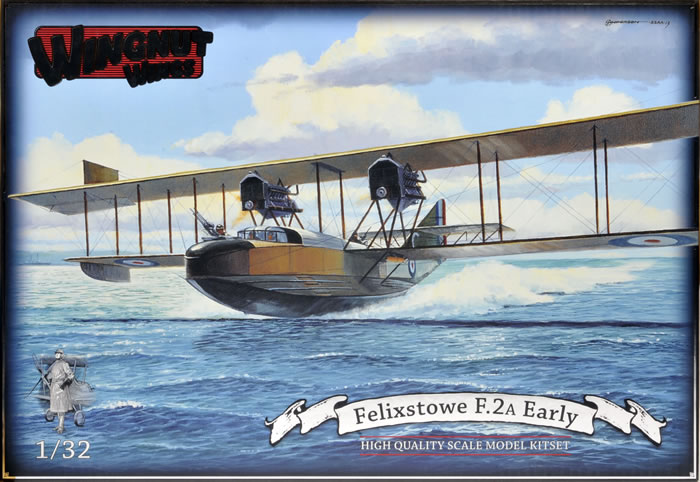
Wingnut Wings, 1/32 scale
| S u m m a r y |
Catalogue Number: |
Wingnut Wings Kit No. 32050 - Felixstowe F.2A Early |
Scale: |
1/32 |
Contents and Media: |
378 parts in grey injection moulded plastic; three parts in clear; 47 photo-etched parts; markings for five options on one decal sheet; instruction booklet. |
Price: |
USD$269.00 with free shipping worldwide, available online from Wingnut Wings' website. |
Review Type: |
First Look |
Advantages: |
Large and spectacular subject; very high level of detail including both engines and full interior; first-rate moulding; subtle and convincing surface textures; beaching gear and testles are included; removable outer wing sections for transport and storage; high quality instructions with reference notes and photos; five marking options on high quality Cartograf decal sheets. |
Disadvantages: |
|
Conclusion: |
Wingnut Wings' 1/32 scale Felixstowe F.2A is a remarkable kit in every respect.
381 plastic parts does not sound too scary these days, but the sheer size of the model combined with sixteen wing struts and associated rigging means that this will be best suited to experienced modellers.
This is a major, luxurious project that will offer many hours of enjoyment, and great satisfaction when the big flying boat is finally sitting on your display shelf.
Highly Receommended. |
Reviewed by Brett Green

HyperScale is proudly supported by Squadron
The Felixstowe F.2 was a 1917 British flying boat class designed and developed by Lieutenant Commander John Cyril Porte RN at the naval air station, Felixstowe during the First World War adapting a larger version of his superior Felixstowe F.1 hull design married with the larger Curtiss H-12 flying boat. The Felixstowe hull had superior water contacting attributes and became a key base technology in most seaplane designs thereafter.
Before the war Porte had worked with American aircraft designer Glenn Curtiss on a flying boat, America in which they intended to cross the Atlantic in order to win the £10,000 prize offered by the British Daily Mail newspaper for the first aircraft to cross the Atlantic. Following the outbreak of war in Europe, Porte returned to England and rejoined the Royal Navy, eventually becoming commander of the naval air station at Felixstowe where he recommended the purchase from Curtiss of an improved version of the America flying boat on which he had worked, the Curtiss H-4 type, resulting in the RNAS receiving two prototype Americas and 62 H-4s.
The Curtiss H-4s were found to have a number of problems, being underpowered with its hull too weak for sustained operations and having poor handling characteristics when afloat or taking off. One flying boat pilot, T.D. Hallam, wrote that they were "comic machines, weighing well under two tons; with two comic engines giving, when they functioned, 180 horsepower; and comic control, being nose heavy with engines on and tail heavy in a glide."
To try to resolve the H-4's hydrodynamic issues, in 1915 Porte carried out a series of experiments on four H-4s fitted with a variety of modified hulls, using the results of these tests to design a new 36-foot-long (11 m) hull which was fitted to the wings and tail of an H-4, serial number 3580, with a pair of 150 hp (112 kW) Hispano-Suiza 8 engines as the Felixstowe F.1. Rather than the lightweight boat-type structure of the Curtiss boats, the F.1's hull was based around a sturdy wooden box-girder similar to that used in contemporary landplanes, to which were attached a single-step planing bottom and side sponsons. Once modified by the fitting of a further two steps, the new hull proved to give much better take off and landing characteristics and was much more seaworthy.
Porte then designed a similar hull for the larger Curtiss H12 flying boat, which while larger and more capable than the H-4s, shared failings of a weak hull and poor water handling. The combination of the new Porte-designed hull, this time fitted with two steps, with the wings of the H-12 and a new tail, and powered by two Rolls-Royce Eagle engines was named the Felixstowe F.2 and first flew in July 1916, proving greatly superior to the Curtiss on which it was based. It entered production as the Felixstowe F.2A, being used as a patrol aircraft, with about 100 being completed by the end of World War I. Another seventy were built, and these were followed by two F.2C which were built at Felixstowe.
In February 1917, the first prototype of the Felixstowe F.3 was flown. This was larger and heavier than the F.2, giving it greater range and heavier bomb load, but poorer agility. Approximately 100 Felixstowe F.3s were produced before the end of the war.
The Felixstowe F.5 was intended to combine the good qualities of the F.2 and F.3, with the prototype first flying in May 1918. The prototype showed superior qualities to its predecessors but the production version was modified to make extensive use of components from the F.3, in order to ease production, giving lower performance than either the F.2A or F.5.
Operational History
The Felixstowe F.2A was widely used as a patrol aircraft over the North Sea until the end of the war. Its excellent performance and maneuverability made it an effective and popular type, often fighting enemy patrol and fighter aircraft, as well as hunting U-boats and Zeppelins. The larger F.3, which was less popular with its crews than the more maneuverable F.2A, served in the Mediterranean as well as the North Sea.
The F.5 did not enter service until after the end of World War I, but replaced the earlier Felixstowe boats (together with Curtiss flying boats) to serve as the RAF's standard flying boat until being replaced by the Supermarine Southampton in 1925.*
Wingnut Wings’ 1/32 scale Felixstowe F.2A Early comprises 378 parts in grey injection moulded plastic, three parts in clear, 47 photo-etched parts and markings for five aircraft.
This is a big model. Seriously big. The wing span is 91cm. That's almost 3 feet for the non-metric amongst our visitors.
In common with their earlier releases, Wingnut Wings' Felixstowe features beautifully moulded surface texture including subtly stretched fabric, fine strips and stitching, crisply recessed panel lines and raised details where appropriate.
The kit features a very complete interior including framed sidewalls, timber floor, 1st and 2nd pilot positions (side by side in the cockpit), control columns complete with wheels and chains, fuel tanks and plumbing, typical throttle and switch detail (configurations changed from one aircraft to another), gunners' positions including lovely Lewis guns and ammo drums. The photo-etched fret supplies lap harness straps for the pilots as well as the chains.
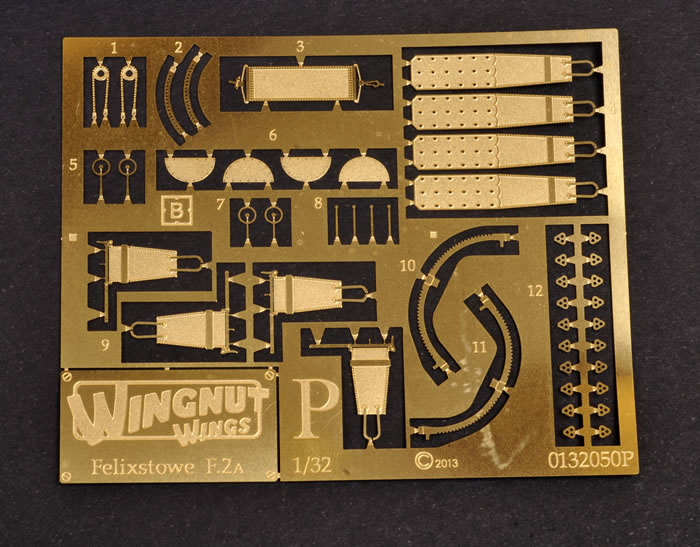
The instructions offer a nice double-page spread covering painting and rigging/bracing the cockpit.
The fuselage and tail planes are built up quite conventionally. The elevators and rudder are separate parts and may be posed to taste. The horizontal tail is reinforced with four struts on each side plus a maze of rigging.
The early version Felixstowe was fitted with a semi-enclosed cockpit. Three clear parts are supplied for the windscreen and optional side panels.
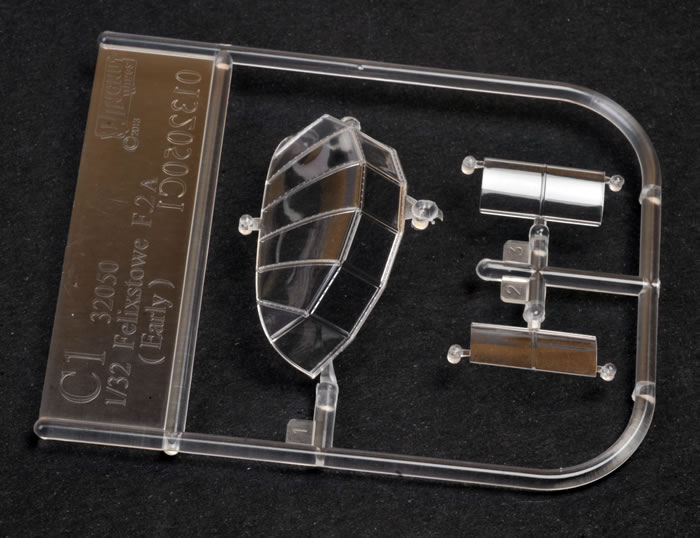
Each Rolls Royce Eagle VIII engine is made up from 26 plastic parts for the basic unit plus bearers, pipes, radiators, manifolds and more. All this glorious detail will be on display when the model is finished, so your efforts in careful assembly, painting and weathering will not go unnoticed.
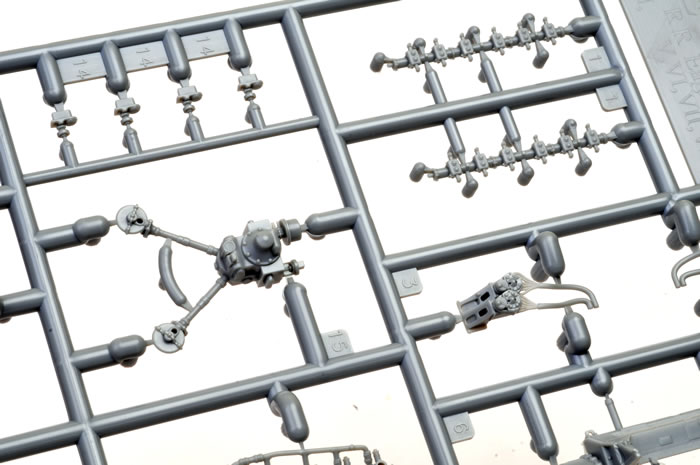
Cabane struts have been cleverly designed as an integrated unit with the main engine bearers. The completed engine assemblies will be mounted on top of the lower inboard wing sections, secured further by the hull bracing struts.
The wing sections are large and heavy - not surprising when you consider that the span is close to one metre. Each outer wing section is moulded in one piece with a stout locating tab. The instructions advise that the outer wing panels don't have to be glued in place, thoughtfully permitting them to be removed for storage or transport. This will make it easier to handle the model during the painting stage too.

The 12 interplane struts are each presented as individual mouldings and are equipped with good-sized locating pins that fit into corresponding holes in the wings.
The most intimidating aspect of the build for most modellers will be the rigging, which I think overtakes the FE.2B to win the title of most complex arrangement of any of Wingnut Wings' releases to date. The wires themselves are all conventional round profile rigging, but you will be using triangular photo-etched parts (supplied on the kit's photo-etched fret) to effectively split some rigging from one wire to two. Several pages of the instructions are dedicated to showing the rigging in large, clear diagrams, colour coded to illustrate the different styles of rigging material. There are also hints and tips on rigging that may be found on Wingnut Wings' website.
A well detailed beaching trolley plus trestles for the wing tip floats and the aft hull are the icing on this remarkable cake.
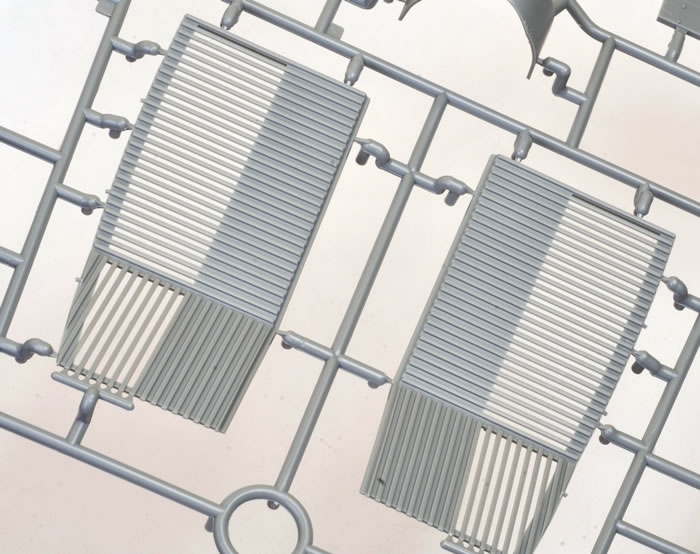
The excellent 32 page instruction booklet is presented in the same format as its predecessors, with 3D construction views supplemented by generous reference photos of wartime machines.
Marking Options
Five very different schemes are supported on the one large decal sheet.

You're on your own with the two dazzle schemes though, as neither decals nor masks are provided for the busy patterns. I'm sure the after market will address this opportunity shortly!

The decal sheet is printed by Cartograf.
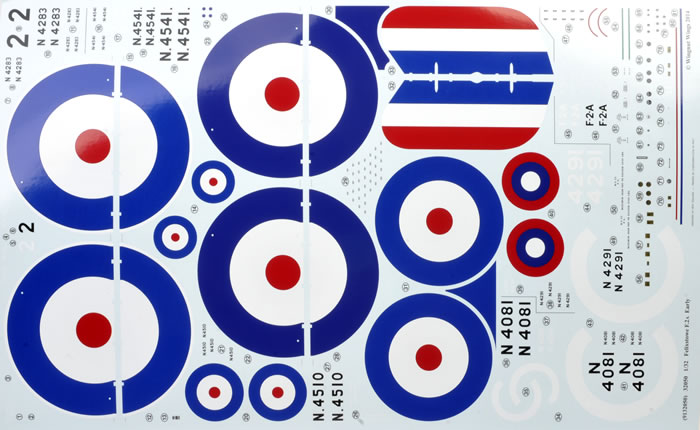
They are in perfect register and feature thin surrounds. Stencil markings along with the aforementioned instruments accompany the unique aircraft decals.
We have seen some large and impressive models over the last few years, including the Airfix 1/24 scale Hawker Typhoon, HK Models' 1/32 scale B-17G Flying Fortress and Tamiya's remarkable F4U Corsair, Mustang and Spitfire families.
Wingnut Wings has been releasing consistently high quality WWI aircraft kits since early 2009, but this is easily their largest, and I believe most spectacular release. Judging by the buzz on Internet Forums, other modellers agree - and not just WWI modellers.
Wingnut Wings' 1/32 scale Felixstowe F.2A is a remarkable kit in every respect. Its sheer size will command attention, detail is excellent, surface textures are subtle and convincing, engineering is thoughtful (I particularly like the removable outer wings for ease of transport), and if previous releases are anything to go by, fit should be excellent.
381 plastic parts does not sound too scary these days, but the sheer size of the model combined with sixteen wing struts and associated rigging means that it will be best suited to experienced modellers.
Don't rush it. This is a major, luxurious project that will offer many hours of enjoyment, and great satisfaction when the big flying boat is finally sitting on your display shelf.
Highly Recommended.
* Development and operational history courtesy of Wikipedia
Thanks to Wingnut Wings for the sample kit.
Review Text and Images Copyright © 2015 by Brett Green
Page Created 2 January, 2015
Last updated
2 January, 2015
Back to HyperScale Main Page

|
